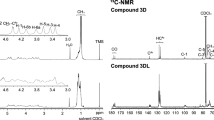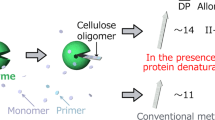Abstract
Novel cellobiose and cellulose (DP n =ca. 30) derivatives, N-(1-pyrenebutyloyl)-4-O-(β-d-glucopyranosyl)-β-d-glucopyranosylamine (6), N-(15-(1-pyrenebutyloylamino)-pentadecanoyl)-4-O-(β-d-glucopyranosyl)-β-d-glucopyranosylamine (7), N-(1-pyrenebutyloyl)-β-cellulosylamine (13), N-(15-(1-pyrenebutyloylamino)-pentadecanoyl)-β-cellulosylamine (14) carrying a pyrene group as a single fluorescent probe at the reducing end, were prepared in order to investigate their self-assembly systems in solutions. The relative intensity of the excimer emission at ca. 480 nm due to dimerized pyrenes (intensity I E) to the monomer emission at ca. 380 nm due to isolated pyrene (intensity I M), i.e., I E/I M, was monitored in various solutions. In water/dimethyl sulfoxide (DMSO) mixed solvent (0–98%, v/v), the ratio I E/I M remained low (0.04) for compound 6 over the range of water concentrations, indicating that pyrenes at C-1 position of compound 6 were diffused. On the other hand, the ratio I E/I M increased (0.04–4.96) for compound 7 with the increase in water concentration, indicating that pyrenes at C-1 position were associated. In aqueous NaOH solutions (4.4–17.5%, w/w), compound 14 showed a large increase in the ratio I E/I M (0.84–8.14) with the increase in NaOH concentration, compared to compound 13 (0.06–0.41). It was found that the association of hydrophobic groups at the reducing-end of cellulose could be controlled by the hydrophilic–hydrophobic balance of compounds and the solvent polarity.
Similar content being viewed by others
References
Akiyoshi K., Deguchi S., Moriguchi N., Yamaguchi S., Sunamoto J. (1993). Self-aggregates of hydrophobized polysaccharides in water - formation and characteristics of nanoparticles. Macromolecules 26(12):3062–3068
Baptistella L.H.B., Dos Santos J.F., Ballabio K.C. and Marsaioli A.J.(1989). 1,8-diazabicyclo[5.4.0]undec-7-ene as a mild deprotective agent for acetyl groups. Synthesis 21:436–438
Birks J.B., (1970). Photophysics of aromatic molecules. Wiley-Interscience, London, p. 1
Ding J., Liu G. (1998). Water-soluble hollow nanospheres as potential drug carriers. Journal of Physical Chemistry B 102(31):6107–6113
Glushko V., Thaler M.S.R. and Karp C.D. (1981). Pyrene fluorescence fine structure as a polarity probe of hydrophobic region: Behavior in model solvents. Archives of Biochemistry and Biophysics 210(1):33–42
Guo A., Liu G. and Tao J.(1996). Star polymers and nanospheres from cross-linkable diblock copolymers. Macromolecules 29(7):2487–2493
Isogai A. (1997). NMR analysis of cellulose dissolved in aqueous naoh solutions. Cellulose 4(2):99–107
Kalyanasundaram K. and Thomas J.K. (1977). Environmental effects on vibronic band intensities in pyrene monomer fluorescence and their application in studies of micellar systems. Journal of American Chemical Society 99(7):2039
Kamitakahara H. and Nakatsubo F. (2005). Synthesis of diblock copolymers with cellulose derivatives 1 Model study with azidoalkyl carboxylic acid and cellobiosylamine derivative. Cellulose 12(2):209–219
Kamitakahara H., Enomoto Y., Hasegawa C. and Nakatsubo F. 2005. Synthesis of diblock copolymers with cellulose. 2. Characterization and thermal properties of cellulose triacetate-block-oligoamide-15. Cellulose in press
Kataoka K., Togawa H., Harada A., Yasugi K., Matsumoto T. and Katayose S.(1996). Spontaneous formation of polyion complex micelles with narrow distribution from antisense oligonucleotide and cationic block copolymer in physiological saline. Macromolecules 29(26): 8556–8557
Kobayashi A., Matsuzaki F., Yanaki T. and Morishima Y. (1999). Solubilization properties of n-substituted amphiphilic acrylamide copolymers. Journal of Applied Polymer Science 73(12):2447–2453
Morawetz H. (1989). Fluorescence studies of polymer dynamics. Journal of Luminescence 43(2):59–71
Ringsdorf H., Venzmer J. and Winnik F. (1991). Fluorescence studies of hydrophobically modified poly(N-isopropylacrylamides). Macromolecules 24(7):1678–1686
Thomas J.K.(1980). Radiation-induced reactions in organized assemblies. Chemical Reviews 80(4):283–299
Thurmond K., Kowalewski T. and Wooley K. (1996). Water-soluble knedel-like structures: The preparation of shell-cross-linked small particles. Journal of the American Chemical Society 118(30):7239–7240
Weast R.C.(1973). Handbook of chemistry and physics. Chemical Rubber Publishing Co., Cleveland, Ohio, p. E51
Winnik M.A. 1987. In West W.J. and Munro H.S. (eds), Polymer Surfaces and Interfaces. New York, Chapter 1, p. 1
Winnik F. (1990). Fluorescence studies of aqueous-solutions of poly(N-isopropylacrylamide) below and above their LCST. Macromolecules 23(1):233–242
Winnik M., Bystryak S., Liu Z. and Siddiqui J.(1998). Synthesis and characterization of pyrene-labeled poly(ethylenimine). Macromolecules 31(20):6855–6864
Winnik F., Winnik M., Tazuke S. and Ober C. (1987). Synthesis and characterization of pyrene-labeled (hydroxypropyl)cellulose and its fluorescence in solution. Macromolecules 20(1):38–44
Acknowledgements
This investigation was supported in part by a Grant-in-Aid for Scientific Research from the Ministry of Education, Science, and Culture of Japan (Nos. 11760122, 13760132, and 15780124).
Author information
Authors and Affiliations
Corresponding author
Rights and permissions
About this article
Cite this article
Enomoto, Y., Kamitakahara, H., Takano, T. et al. Synthesis of diblock copolymers with cellulose derivatives. 3. Cellulose derivatives carrying a single pyrene group at the reducing-end and fluorescent studies of their self-assembly systems in aqueous NaOH solutions. Cellulose 13, 437–448 (2006). https://doi.org/10.1007/s10570-005-9005-4
Received:
Accepted:
Published:
Issue Date:
DOI: https://doi.org/10.1007/s10570-005-9005-4




